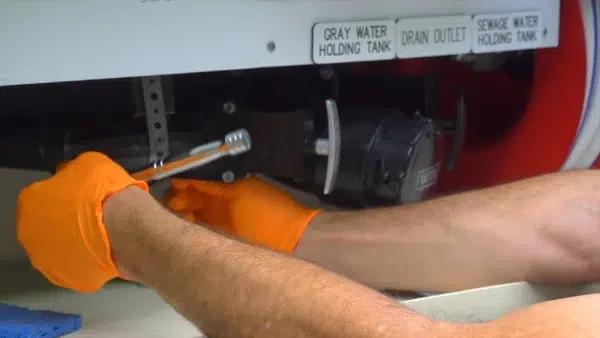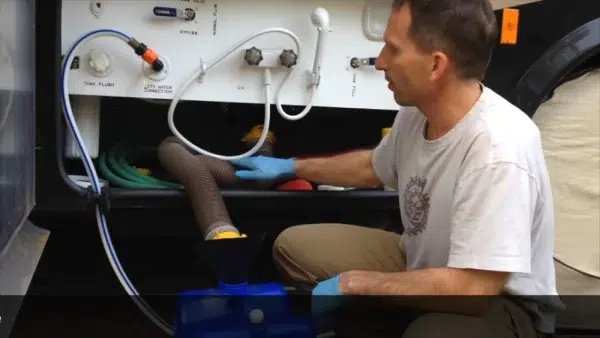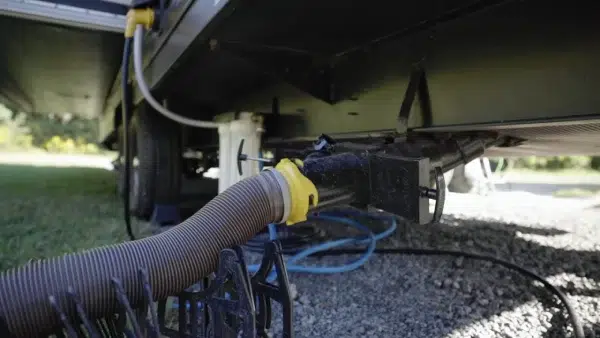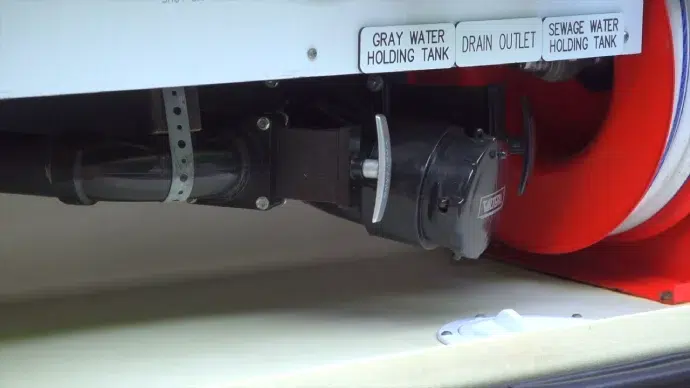Last Updated on May 25, 2023
Do you ever have a problem with the grey tank in your RV not draining? There are several reasons your RV’s grey tank may not drain. Some of the most common issues include blockages in the drainage system, malfunctioning valves, or clogs in the vent pipe.
A blockage in your RV’s gray water drainage system can cause backups and prevent the gray tank from draining correctly. The same holds for malfunctioning valves or handles. These can prevent the grey tank from opening up and emptying into the sewer system.
Today we’ll explore some common reasons why your RV’s grey tank may not drain correctly and what you can do to fix it. So let’s get to the bottom of this pesky problem.
Why is My RV Grey Tank Not Draining: Some Common Causes

When you’re out on the road with your RV, a grey tank not draining can be a frustrating and messy problem. Several common causes could lead to this issue.
Blockages in the Drainage System
Blockages in the drainage system are among the most common reasons for an RV grey tank not draining in RVs. Blockages can occur for various reasons, such as dumping inappropriate items down the drain or accumulating debris and waste over time.
A blocked drainage system can lead to unpleasant odors, overflowing sinks or showers, and even damage your RV’s plumbing. Therefore, it is essential to address the issue as soon as possible.
Malfunctioning Valves or Handles
One of the common causes of a grey tank not draining is malfunctioning valves or handles. This issue can occur due to wear and tear over time or result from improper use.
The valve or handle that controls the flow of water from the RV grey tank to the RV sewer system may become stuck, making it difficult or impossible for water to drain properly. Sometimes, the valve may leak, causing water to accumulate in the tank and preventing it from emptying.
Damaged Plumbing or Fittings
Damaged plumbing or fittings can significantly cause your RV grey tank not to drain correctly. This happens for many reasons, like deterioration over time, poor installation, or even accidental damage.
When the plumbing system is damaged, it can cause leaks and blockages, preventing the grey water from flowing freely out of the tank.
If you suspect your RV’s plumbing system is damaged, it’s essential to address the issue immediately. Ignoring this problem can lead to more severe issues, such as water damage to your RV’s interior.
Clogs in the Vent Pipe
Clogs in the vent pipe can also cause a grey tank not to drain correctly. Air enters the plumbing system through the vent pipe, which equalizes pressure and prevents suction.
If the vent pipe becomes clogged, it can cause negative pressure to build up in the grey tank, making it difficult or impossible for the tank to drain.
There are several reasons why a vent pipe may become clogged. One of the most common causes is debris, such as leaves or twigs getting stuck in the pipe. In addition, bird nests or other small animals may build their homes inside the vent pipe, causing a blockage.
How to Troubleshoot a Grey Tank That Won’t Drain?

If you’re experiencing trouble with your RV’s grey tank not draining, you can take a few troubleshooting checks to get it back in working order.
CHECK #1. Inspect the Drainage System for Blockages
When your RV grey tank is not draining, it can be a frustrating experience. One of the most common causes of this issue is blockages in the drainage system. This can occur due to debris buildup, such as food particles, grease, and other waste materials accumulating over time.
Remove any visible debris from the drain opening to inspect the drainage system for blockages. You can use gloves and a flashlight to help you see better. Next, insert a plumbing snake or wire hanger into the drain to clear any clogs that may be present.
CHECK #2. Investigate for Malfunctioning Valves or Handles
A common cause of an RV grey tank not draining in an RV is malfunctioning valves or handles. The valves and handles control the wastewater flow from the grey tank to the sewer system. If they are not functioning correctly, it can lead to a backup in the system.
First, locate them in your RV to check for malfunctioning valves or handles. They are typically found near the grey tank and may be labeled as such. Once located, inspect them for any visible damage or wear and tear. They will need to be replaced if they appear damaged or broken.
If there is no visible damage, test the valves and handles by opening and closing them several times. Make sure they move smoothly without any resistance. If you notice any difficulty in moving them or if they get stuck in one position, this could indicate a malfunction.
CHECK #3. Examine Plumbing and Fittings for Damage
One of the typical causes of a gray tank not draining is damaged plumbing or fittings. Plumbing and fittings are essential to your RV’s drainage system; any damage can lead to leaks, blockages, and other issues.
The first step in troubleshooting this problem is to inspect the plumbing and fittings for any visible signs of damage. This may include cracks, leaks, or loose connections. If you notice any damage, addressing it as soon as possible before it worsens is essential.
In some cases, the issue may be with the fittings themselves. Over time, fittings can become worn or damaged due to exposure to harsh chemicals or extreme temperatures. If you suspect that your fittings are causing the issue, it may be necessary to replace them.
CHECK #4. Clear Any Clogs in the Vent Pipe
A clogged vent pipe can be another reason for a grey tank not draining properly. The vent pipe allows air to enter the plumbing system, which helps with the flow of water and waste. If this pipe becomes blocked, it can cause a backup in your grey tank.
To clear any clogs in the gray tank vent pipe, you will need to locate it on your RV’s roof. It is usually a small pipe sticking out from the top of your RV. Once you have found it, inspect it for visible blockages such as debris or leaves.
If you notice any blockages, use a plumber’s snake or a long wire coat hanger to remove them gently. Be careful not to damage the vent pipe while doing so. You can also use compressed air to blow out any debris stuck inside.
Sometimes, the clog may be too severe for these methods to work. If this is the case, you may need to hire a professional plumber or RV technician to help clear the clog.
Preventative Measures to Keep Your Grey Tank from Not Draining
Maintaining your RV’s grey tank is crucial to ensure it drains properly. Neglecting this important aspect can result in costly repairs and unpleasant odors inside your RV. Here’s how to get your grey water tank to drain:
Regular Maintenance
Regular maintenance is essential to keep your RV’s grey tank draining properly. Neglecting to perform regular maintenance can lead to blockages and other issues that can be costly and time-consuming to fix. The good news is that maintaining your grey tank is relatively easy and doesn’t require a lot of time or effort.
One of the most important things you can do to maintain your grey tank is to clean it regularly. This means flushing it out with clean water every few weeks or after each trip. Flushing the tank helps remove any buildup of debris, soap scum, and other materials that can cause blockages.
You should also regularly inspect the tank’s valves and handles to ensure they function correctly. If you notice any leaks or damage, replace them immediately. Damaged valves or handles can prevent tank drainage, causing backups and other problems.
Proper Disposal of Waste and Grease
Poor waste and grease disposal is the most significant cause of grey tanks not draining. It’s important to remember that your RV’s grey tank is designed to hold wastewater from sources such as sinks, showers, and washing machines. However, it’s not meant to dispense food scraps or cooking oils.
Food scraps and cooking oils can accumulate in the grey tank and cause blockages when dumped down the drain. This can prevent the tank from draining properly, leading to unpleasant odors and potential damage to your RV’s plumbing system.
To avoid this issue, dispose of food scraps and cooking oils in the trash instead of down the drain. You can also use a filter in your sink to catch any food particles before they go down the drain.
Installation of Additional Equipment
One way to prevent your RV grey tank from not draining is by installing additional equipment. There are several options available that can help improve the drainage system of your RV.
One popular option is a grey water tank cleaning wand. This tool attaches to a garden hose and allows you to blast away any buildup or debris causing blockages in the tank or pipes. It’s important to use caution when using this tool, as too much pressure can damage the plumbing.
Another option is a grey-water tank treatment solution. These solutions contain enzymes and bacteria that break down waste and grease buildup in the tank, helping to prevent clogs and odors. They are typically added directly to the tank through the sink or shower drain.
Can I use Drano in an RV grey water tank to unclog it?

While using a powerful drain cleaner like Drano to unclog an RV grey water tank may be tempting, doing so can cause more harm than good. Drano is an acidic cleaner, potentially damaging the RV’s black and grey tanks if used incorrectly.
The chemicals in Drano can cause corrosion and wear down the materials used in RV plumbing over time, leading to leaks and other issues. Instead of relying on Drano or other harsh chemicals, unclogging an RV grey water tank should be done using safer and more appropriate methods.
Can I use vinegar to unclog the RV gray water tank?
When unclogging your RV water tanks, vinegar can be a beneficial ingredient, but it shouldn’t be used alone. Instead, a mixture of white vinegar and bicarbonate of soda can help break down blockages in your RV’s grey water tank.
To use vinegar to unclog your grey water tank, dump a cup of bicarbonate of soda down the drain. Then, pour a cup or more of white vinegar into the drain. The reaction between the two ingredients should begin to fizz and bubble, which can help loosen and break down any blockages in the drain pipes.
Allow the solution to sit in the tank for some time before flushing with hot water. This can be a gentle yet effective method for cleaning your RV grey water tank. Alternatively, using a commercially available cleaning product specifically designed for RV plumbing systems can also provide excellent results.
Unclog Your Grey Tank – Essential Maintenance for Long-Term RV Functionality
If you ever find yourself asking, “Why is my RV grey tank not draining?” – there are a variety of potential causes to consider. Blockages in the RV drainage system, malfunctioning valves or handles, damaged plumbing or fittings, and clogs in the vent pipe are common culprits that can prevent proper draining.
To troubleshoot the issue, it’s essential to inspect all these areas and take steps to clear any blockages or fix any malfunctions. However, the best course of action is always preventative maintenance.
Regularly maintaining your RV’s grey tank, properly disposing of waste and grease, and installing additional equipment can help avoid future problems with draining.
By following these tips and staying on top of maintenance, you can ensure your RV’s grey tank functions smoothly and efficiently for years.



